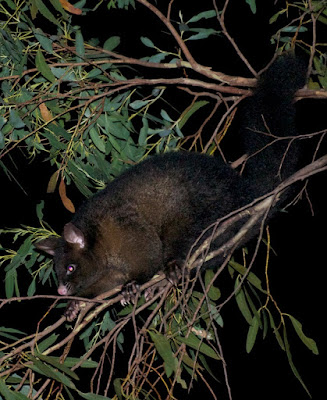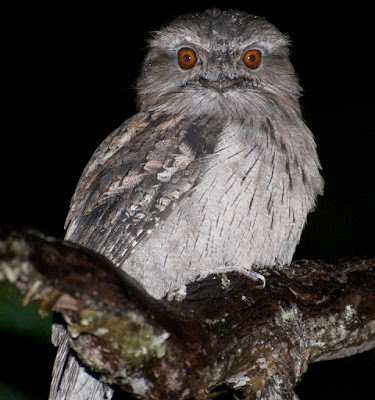After our long day at Cradle Mountain (March 26, 2014), sleep was certainly high on all our minds; but I couldn't resist taking Ryan on a brief night walk around our cabin site. We didn't find a great deal, but we did see some animals that we would have missed if we had gone to bed. Ryan was a bit nervous about the dark, but was game all the same.
We had already seen Tasmanian Padamelons (Thylogale billardierii) by day, but they were certainly more active after dark.
New for Ryan, though, were two Common Brushtail Possums (Trichosurus vulpecula) hissing at each other in a clump of eucalyptus trees (we heard them before we saw them). I have seen plenty of Brushtails in my time, but the rich color of these Tasmanian animals (subspecies fuliginosus) was a surprise to me.
Brushtails I have seen on the mainland (and in New Zealand, where they are an abundant human introduction) are, usually, mostly grey. They are, however, very variable, and the two we saw - one rich rufous, the other almost entirely black - represent colour forms, not age or gender differences.
The Tasmanian race is larger and more densely-furred than mainland possums, and I think the ones we found were very handsome animals indeed. I especially liked the contrast of the black possum's bare, bright pink muzzle.
Our other find for the night was a Tawny Frogmouth (Podargus strigoides), a widespread Australian bird that (for my Malaysian readers) is a whole lot easier to see than its Asian relatives (and if any of my Sarawakan friends feel otherwise, they are welcome to show me all the frogmouths they like the next time I get to Kuching).
For those unfamiliar with frogmouths, they may look like owls but are actually much closer to nightjars (though they are considerably larger, and perch quite differently). They also let you approach quite closely, a behaviour I certainly appreciated.
With that, we were off to bed. The next day was devoted to a long, rainy and (I'm afraid) not very interesting drive southwest to the little seaport of Strahan, on the west coast, where the chief highlight was a well-stocked ice cream shop. I had hoped we would pass enormous Mountain Ash trees like those I had seen on the road to Lake Pedder in 1974, but instead we seemed to be mostly in plantation forest or mining country.
However, our route did take us to the southern, Lake St. Clair end of Cradle Mountain-Lake St. Clair National Park, where we spent the nigh in a very nice cabin and had another chance for a night walk. I was hoping for a sighting of Eastern Quoll (Dasyurus viverrinus), an animal supposedly common here but extinct (thanks largely to foxes and cats) on the Australian mainland, but it was not to be. We did, however, turn up a few more pademelons.
We also came across another frogmouth...
...as tame, and as irresistable, as the one we had seen the night before. This was our last evening in Tasmania, so the extra frogmouth was a nice bonus.

















No comments:
Post a Comment